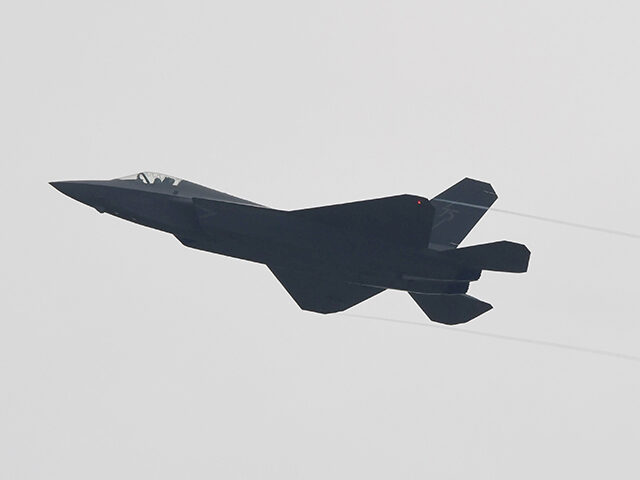Chinese state media on Wednesday coyly confirmed that a mysterious aircraft spotted over the southwestern Sichuan province last week was a new sixth-generation stealth fighter, ostensibly the most advanced combat aircraft in the world.
No official designation for the plane has been released to the public, but state media is playing up its resemblance to a triangle-shaped gingko leaf.
The “Gingko Leaf” nickname was pushed by the social media account of a publication called Defense Times, which posted a picture of the eponymous plant with the unexplained caption “it really looks like a leaf.”
Observers took this as subtle government-approved confirmation that the mystery plane which flew over Sichuan in broad daylight on December 26 was a new stealth fighter produced by the Chengdu Aircraft Industry Group.
Other social media accounts linked to the Chinese government or its People’s Liberation Army (PLA) soon posted photos of either the plane or the gingko leaf. A music video produced by the PLA to celebrate the new year on Wednesday also included a brief and unexplained image of a gingko leaf and a bird. The bird was interpreted by state media as an allusion to an alternative sixth-generation fighter design.
China’s state-run Global Times on Wednesday said the juxtaposition of the menacing and mysterious images in the video with its musical soundtrack, a song called “Chinese People” that urges Taiwanese and mainland residents to “let the world know we are all Chinese,” was a carrot-and-stick message to Taiwan that stressed “reunification” is inevitable, and the Taiwanese will choose to be persuaded with carrots if they know what’s good for them.
According to the Global Times, the PLA wanted to send the message that Taiwanese who insist on remaining independent from China are dangerous lunatics who want to provoke a war Taiwan cannot possibly win:
Experts said that the PLA Eastern Theater Command specially selected the “Chinese People” as the theme song for the music video, showing that compatriots on both sides of the Taiwan Straits are Chinese people. The video clip also demonstrates a scene of teachers and students from universities in the Chinese mainland visiting Taiwan and being warmly welcomed, reflecting the deep friendship between compatriots across the Straits. These scenes of harmonious coexistence also convey a signal that the Chinese mainland hopes that the majority of Taiwan compatriots can see the true face of “Taiwan independence” separatist forces and work together with mainland compatriots to promote the peaceful development of cross-Straits relations.
[Military expert Zhang Jungshe] said that the video shows no matter if it is on workdays or holidays, troops are always on high alert and in a state of combat readiness to fight at any time. Through the video, the Chinese people can rest assured about the determination and ability of the PLA to defend the country, suppress secession, and safeguard national unity and security.
Zhang congratulated the PLA for responding “strongly” to the “provocations of Taiwan independence separatist forces” and their “collusion with external forces,” meaning the United States. He said the advanced weapons showcased – and, in the case of the new stealth fighter, metaphorically teased – in the PLA music video should make Chinese people “feel proud and excited,” while making “forces with ill intentions toward China feel uneasy.”
The War Zone military blog said it was “something of a stunning development” for China to be flying a “stealthy, sixth-generation crewed combat aircraft” already, let alone two of them.
“The aircraft’s design aligns with China’s aspirations for advanced airpower, emphasizing stealth and long-range capabilities. The tailless configuration is intended to reduce radar signature and improve aerodynamic efficiency, although it may impact maneuverability,” the War Zone noted.
If the Gingko Leaf plane follows expected naming conventions, it would be designated as the J-35. The “bird” design, apparently created by the Shenyang Aircraft Corporation, would be designated the J-50.
It remains debatable whether either of these aircraft would truly meet the qualifications for the as-yet theoretical sixth generation fighter or not. Western military analysts have long debated what the necessary features to mark the beginning of the sixth generation would be, but suggestions include greatly reduced radar and heat signatures (which is why the Chinese mystery planes do not appear to have tail sections), enhanced cyber warfare capabilities, “smart skin” packed with sensors, wings that can change shape in flight to enhance maneuverability, microwave or laser defensive weapons, superior integration with drones, and possibly hypersonic flight speeds.
While Chinese state media is crowing that the Gingko Leaf could make China the first country to fly a sixth-generation plane, the United States actually flew a sixth-generation prototype called Next Generation Air Dominance (NGAD) in 2020.
The NGAD design was more stealthy than the fifth-generation F-22 thanks to its lack of a tail and advanced hull materials, its new engine design was intended to give it longer range with a lower infrared profile, and its sensor suite came close to the “smart skin” ideal of a sixth-generation plane with near-total awareness of its surroundings. The NGAD prototype also tested advanced integration with unmanned aerial vehicles (UAV).
The NGAD design has one major vulnerability: the huge $300 million price tag fluttering off its no-tail posterior. The brief glimpse afforded of China’s putative sixth-generation designs over the past week gave no hint as to its cost-effectiveness, or any of its capabilities beyond their no-tail radar-baffling profiles.

COMMENTS
Please let us know if you're having issues with commenting.